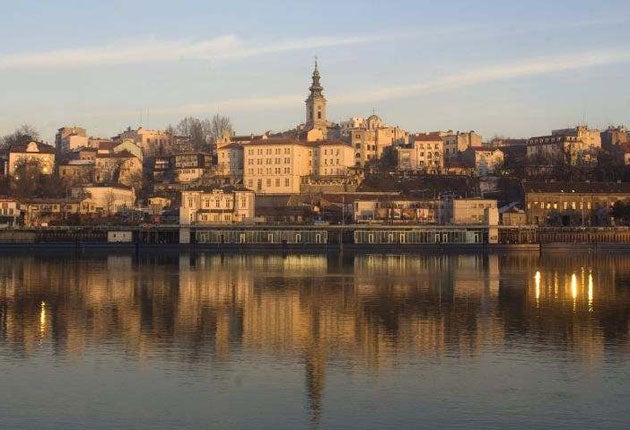Belgrade has risen from the ashes to become the Balkans' party city
Robert Nurden explores Serbia's capital, 10 years after Nato's bombardment

Your support helps us to tell the story
From reproductive rights to climate change to Big Tech, The Independent is on the ground when the story is developing. Whether it's investigating the financials of Elon Musk's pro-Trump PAC or producing our latest documentary, 'The A Word', which shines a light on the American women fighting for reproductive rights, we know how important it is to parse out the facts from the messaging.
At such a critical moment in US history, we need reporters on the ground. Your donation allows us to keep sending journalists to speak to both sides of the story.
The Independent is trusted by Americans across the entire political spectrum. And unlike many other quality news outlets, we choose not to lock Americans out of our reporting and analysis with paywalls. We believe quality journalism should be available to everyone, paid for by those who can afford it.
Your support makes all the difference.If you're a smoker, read on: Belgrade is paradise for puffers. If you're not, proceed with care and decide whether you want to spend time in Serbia's capital, a city that leaves your clothes reeking of cigarettes. There's a new kind of refugee from politically correct Western Europe, looking for lands where fags are cool, and they're fugging up the bars and restaurants.
Luckily, the cool word needn't prevail in this war-torn city at the confluence of the Danube and Sava. Despite being witness to 115 international conflicts and being razed to the ground 44 times, it retains a rough charm that has earned it the moniker of party city par excellence.
The tourist board adopts a "don't mention the wars" policy but independent guides such as mine, Nemanja, pull no punches. They're even happy to give their views on the crazy Radovan Karadzic and point out the bomb sites. It's 10 years since Nato called a halt to its selective bombing campaign. Now Belgrade is rising from its ashes.
For those who like their tourism edgy, this is the place to be. Every day demonstrators unfurl anti-Nato banners in Republic Square. And in Tito Bar the walls are covered in the former leader's memorabilia, while the staff sport Partisan uniforms.
Eating out at a restaurant in Skadarlija is de rigueur. This cobbled bohemian quarter is where Belgrade's arty crowd once gathered, but now – without losing any of its appeal – it's for all-comers. Nemanja and I opted for Sesir Moj (My Hat), an art gallery cum restaurant where the food vies with the pictures in the creativity stakes: carp, grilled meats, smoked ham, an unbelievable apple filo pie. A gypsy band serenades diners and an actress sings Serbian folk songs and grabs foreign men for a twirl on the dance floor.
I had been looking forward to visiting the museum to Nikola Tesla, Serbia's unsung scientific genius, inventor of the alternating current and wireless communication. But it was closed after a spate of break-ins. Closed, too, for renovation were the National Museum and Contemporary Art Museum. Come on, Belgrade, the world wants to see your best side.
In the wood and clay tavern called "?", where a laid-back crowd was hanging out, Nemanja and I drank Serbian tea. This, I gathered, could be either hot rakija or mulled wine: either way it was a heady brew. The bar's strange name came about because more than 100 years ago, the cathedral, which stands opposite, objected to it being called "By the cathedral", so the owner put up the temporary sign "?", and the name stuck.
Across the Sava, past the moored-up pleasure boats, lies peaceful Zemun, once an outpost of the Austro-Hungarian empire facing up to the Ottoman might across the water. The classical architecture of its pink and cream houses speaks of the age of Mozart rather than Balkan bellicosity. The restaurants lining the Danube are peopled by dignified waiters of a certain age for whom nothing is too much trouble.
Back in the city itself, the fortress, which overlooks the point where the rivers meet, is everything you'd expect from a place ravaged by conflict. Aptly, it houses a war museum, and cannon and tanks stand sentinel. The hulking great ramparts are straight out of a fairy tale, but these days the huge complex of Kalemegdan is where Belgraders relax, wandering aimlessly as they shell and munch sunflower seeds.
"This is the lungs of the city," said Nemanja, stubbing out the butt of his cigarette on the stone flagging. I don't know if he saw my wry smile.
Compact facts
How to get there
Jat Airways (020-7629 2007; jatlondon.com) flies from Heathrow to Belgrade from £196 return. Hotel Balkan (00 381 11 363 6000; balkanhotel .net) offers B&B in a double room from €165 per night.
Further Information
The Tourist Organisation of Belgrade, Terazije Passage (00 381 11 334 3460; tob.co.yu). For an independent guide, contact Nemanja Ciric (00 381 64 187 8811).
Join our commenting forum
Join thought-provoking conversations, follow other Independent readers and see their replies
Comments